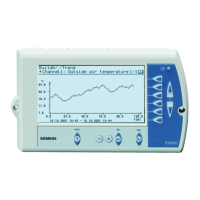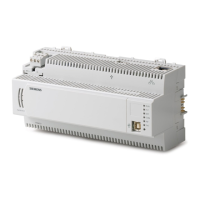PXC Compact on P1
PXC Compact on P1 is used for controlling air handlers or migration of a UC (Unitary
Controller).The P1 Mode Application allows the PXC Compact to function as an FLN
device (emulate a TEC) on an APOGEE P1 FLN, to receive and process P1 FLN
request messages from field panels, Insight workstations, or Commissioning Tool (CT),
and to respond with P1 messages. This feature also allows the PXC Compact on P1 to
receive and process P1 request messages from an APOGEE tool, such as WCIS,
connected to the HMI port.
See the section Minimum Firmware Revision Required [➙ 10] for information on the
firmware revision required to implement PXC Compact operation on P1 FLN.
What is a PXC Compact on P1?
The PXC Compact on P1 uses standard PXC-16 or PXC-24 hardware, but Firmware
Revision 2.8.4 or later allows the PXC Compact to reside on the P1 FLN and
communicate with an ALN (host) field panel. This feature is enabled when P1 is
selected as the ALN in the HMI prompts.
The PXC Compact on P1 functions like a stand-alone ALN field panel, meaning it does
not communicate with any other field panels on the ALN, and so it cannot send or
receive data directly. The PXC Compact on P1 appears to the host field panel on the
FLN as a TEC and its points appear as application subpoints.
The database structure of the PXC Compact on P1 is different from that of a standard
ALN controller since it consists of three parts, which must remain synchronized.
● A standard P2 database
● An Integrated Systems Binary (ISB) file
● A P1 point team database
Table 1: Database Structure of the PXC Compact on P1.
Points
Program (PPCL)
Trend
Scheduler, and so on
P2 to P1 Cross
Reference Table
Point Team
Initial Values
Default Values
COV Limits on FLN, and
so on
Standard P2 Database
Although it is operating on the P1 FLN, the PXC Compact still requires a P2 database.
The standard P2 database for the application is created in CT either by converting a
UC database or by building a new PXC Compact database in the proper structure.
The P2 database is loaded into the PXC Compact on P1 through the HMI port using
MMI Database Transfer. To keep the P2 point names unique in CT, the application
number is added to the beginning of all corresponding point names. This application
number is not used in the P1 database since subpoint names are always unique.

